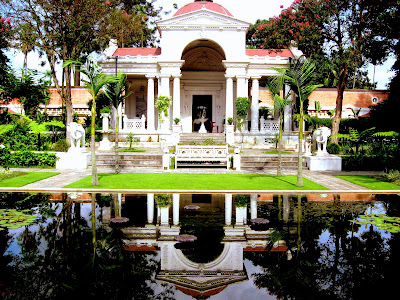To view a Google earth version of the entire trip of which this journey is a part, visit acerminaro - ChinaTibetNepalThailandTrip2007
 After crossing the Peace Bridge of the Friendship Highway linking Nepal and Tibet, we arrive at the rugged border town of Kodari Nepal. Making arrangements for a jeep trip to Kathmandu proves an interesting adventure in itself, as local boys bargain with each other and drivers for commissions, promising to us a ride as soon as the "driver" returns from Tibet. We finally secure a jeep and set out for Kathmandu.
After crossing the Peace Bridge of the Friendship Highway linking Nepal and Tibet, we arrive at the rugged border town of Kodari Nepal. Making arrangements for a jeep trip to Kathmandu proves an interesting adventure in itself, as local boys bargain with each other and drivers for commissions, promising to us a ride as soon as the "driver" returns from Tibet. We finally secure a jeep and set out for Kathmandu.
 The descent from the Tibetan plateau to Kodari is like falling off a brown, barren cliff and landing in a lush green forest, complete with waterfalls and more treacherous winding roads.
The descent from the Tibetan plateau to Kodari is like falling off a brown, barren cliff and landing in a lush green forest, complete with waterfalls and more treacherous winding roads.
 The rewards for continuing the descent on the road to Kathmandu include many small farming outposts set like gems in the greenery.
The rewards for continuing the descent on the road to Kathmandu include many small farming outposts set like gems in the greenery.
 We are transported from the sublime to the ridiculous, through the crazy Kathmandu traffic choked with small cars, bicycles, motorbikes and the acrid fumes that go with them. We arrive in the Thamel tourist area, with its narrow, crowed, colorful alleys - a virtual "Disneyland for backpackers".
We are transported from the sublime to the ridiculous, through the crazy Kathmandu traffic choked with small cars, bicycles, motorbikes and the acrid fumes that go with them. We arrive in the Thamel tourist area, with its narrow, crowed, colorful alleys - a virtual "Disneyland for backpackers".
 Booking a room in the laid-back Kathmandu Guest House, we relax in the tranquil garden before continuing our sightseeing journey.
Booking a room in the laid-back Kathmandu Guest House, we relax in the tranquil garden before continuing our sightseeing journey.
 With our Lonely Planet tour book in hand we take the scenic walking tour arriving at the Kathmandu Durbar Square, one of seven groups of monuments and buildings designated as Kathmandu Valley UNESCO World Heritage sites. Others include the Buddhist stupas of Swayambunath and Boudhanath, and the Hindu temple of Pashupati, which we will visit.
With our Lonely Planet tour book in hand we take the scenic walking tour arriving at the Kathmandu Durbar Square, one of seven groups of monuments and buildings designated as Kathmandu Valley UNESCO World Heritage sites. Others include the Buddhist stupas of Swayambunath and Boudhanath, and the Hindu temple of Pashupati, which we will visit.
 Next day we walk from Thamel across the Bagmati river to Swayambunath, also know as the "monkey" temple in honor of its cavorting simian residents. We climb the "365" steps up a forested hill for a breathtaking view of the Kathmandu Valley from this important Buddhist shrine. For more, see this sacredsites page
Next day we walk from Thamel across the Bagmati river to Swayambunath, also know as the "monkey" temple in honor of its cavorting simian residents. We climb the "365" steps up a forested hill for a breathtaking view of the Kathmandu Valley from this important Buddhist shrine. For more, see this sacredsites page
 Next, we're off to Boudhanath, transfixed by the ever vigilant "Buddha Eves" reminding us to stay on the true path in life. Boudhanath is another holy Buddhist site. Its platform is a massive mandala and it contains the largest spherical stupa in Nepal.
Next, we're off to Boudhanath, transfixed by the ever vigilant "Buddha Eves" reminding us to stay on the true path in life. Boudhanath is another holy Buddhist site. Its platform is a massive mandala and it contains the largest spherical stupa in Nepal.
 A short walk from Boudhanath takes us to the mysterious Pashupatinath Hindu temple, regarded as the most sacred temple of Shiva (Pashupati) in the world. Thousands of pilgrims from all over the globe, particularly from Nepal and India pay homage in this temple everyday. "Shivaratri" or night of lord Shiva is an especially important day in this temple when tens of thousands of people throng here for the annual celebration.
A short walk from Boudhanath takes us to the mysterious Pashupatinath Hindu temple, regarded as the most sacred temple of Shiva (Pashupati) in the world. Thousands of pilgrims from all over the globe, particularly from Nepal and India pay homage in this temple everyday. "Shivaratri" or night of lord Shiva is an especially important day in this temple when tens of thousands of people throng here for the annual celebration.
 Before leaving Kathmandu, we stop at the oasis of calm and beauty that is the "Garden of Dreams," also known at the "Keshar Mahal Palace and Gardens" and the "Garden of the Six Seasons." The garden is a prominent architectural example of Nepal's Rana period, with its mixture of western and oriental elements, and the adjacent neo-classical Palace.
Before leaving Kathmandu, we stop at the oasis of calm and beauty that is the "Garden of Dreams," also known at the "Keshar Mahal Palace and Gardens" and the "Garden of the Six Seasons." The garden is a prominent architectural example of Nepal's Rana period, with its mixture of western and oriental elements, and the adjacent neo-classical Palace.
The complex was built in the 1920s by Keshar Shumshere Rana, the third son of the Rana ruler in power at that time. His gardens abounded with all kinds of plants - not only from Nepal but also from Australia and Europe. The name 'Garden of the Six Seasons' reflects the six seasons prevailing in southern Asia : spring, early summer, summer monsoon, early autumn, late autumn and winter. Each of these seasons was represented with its own pavilion. Only three of the pavilions remain. The site has been and is being restored by Ecohimal.
More photos from my trip are available at Journey to Nepal, my photoset on Flickr


















